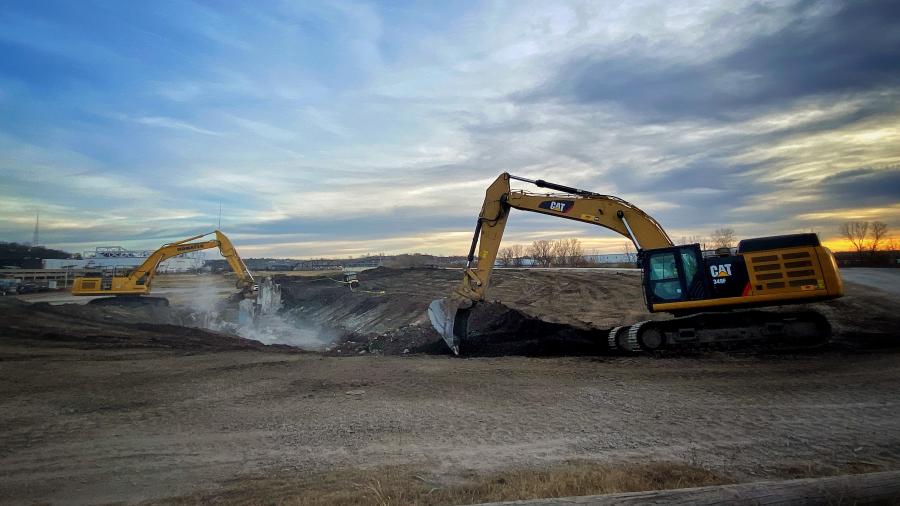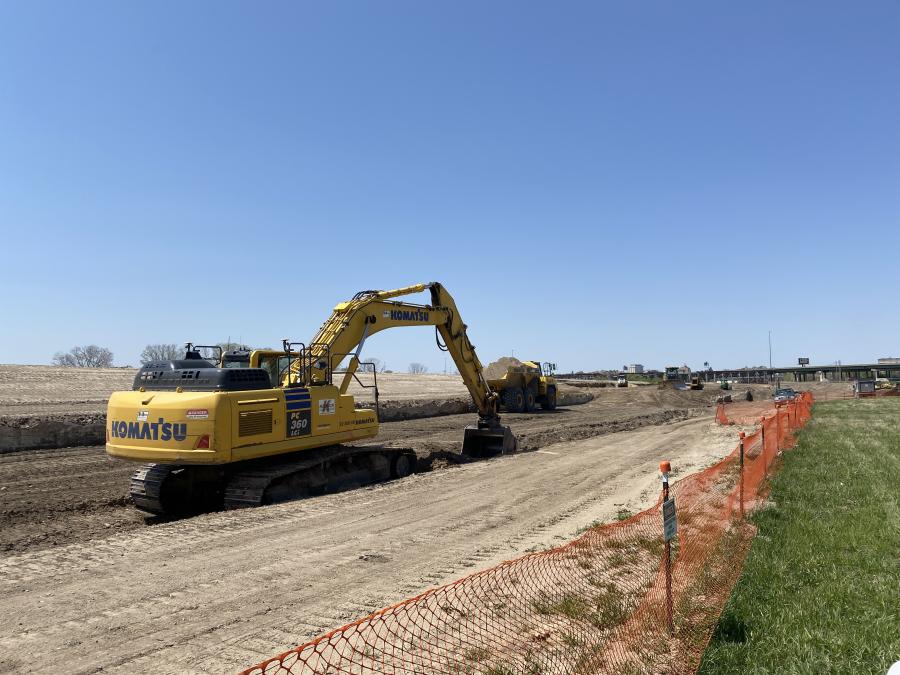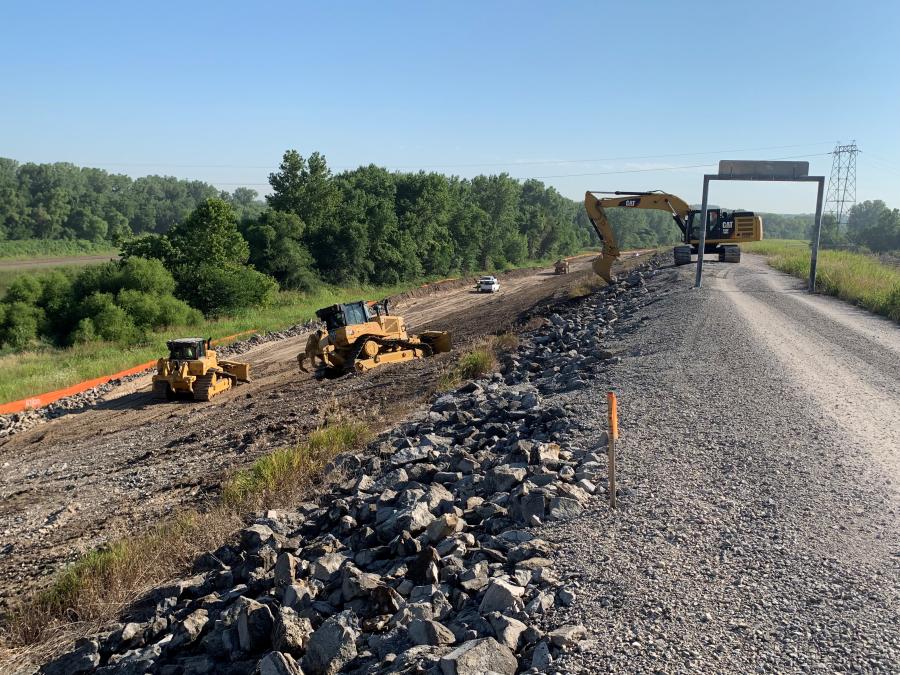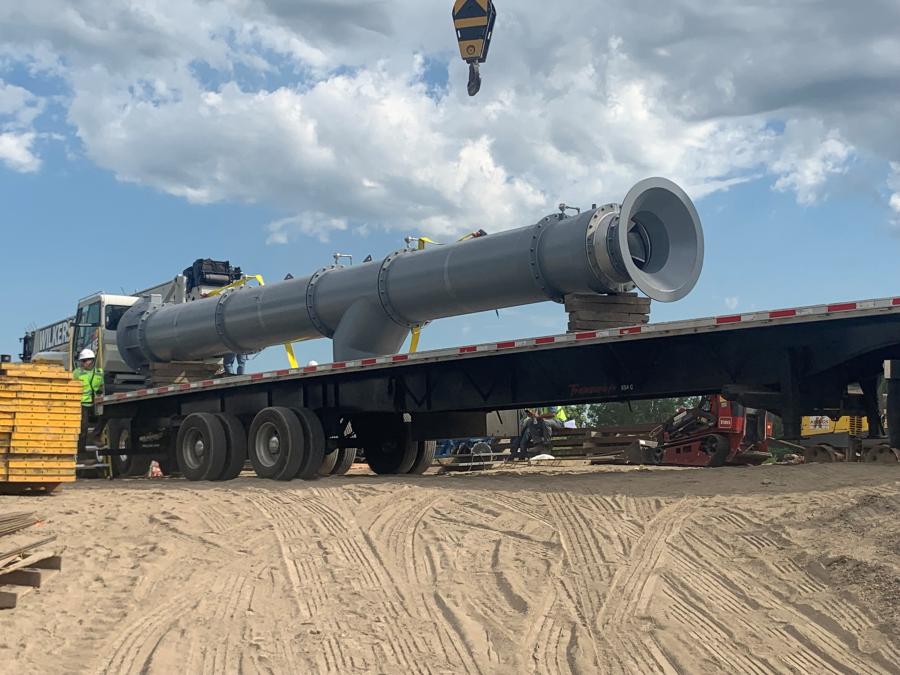Lane Construction demolishes an abandoned structure located along the Central Industrial District Levee Unit.
(U.S. Army Corps of Engineers – Kansas City District photo)
Reconstructing a levee along a river, or erecting a concrete flood wall, is not a monumental task, certainly not for experienced engineers and contractors working under the watchful eye of the U.S. Army Corps of Engineers.
However, throw in hundreds of intersecting utility lines, railroad tracks and trains crowding the work area, limited access to construction sites for work crews, plus the requirement to shift gears and counteract any untimely rise in river waters — and routine construction suddenly gets tricky.
The Corps is overseeing 17 mi. of tricky levee reconstruction and floodwall improvements along the Kansas River within the Kansas City, Kansas-Missouri metropolitan area where an estimated 30,000 people live and/or work. Civil engineer Scott Mensing has managed the levees program for the Corps for almost four years. Lane Construction is the general contractor for the project.
"Each river work site brings its own challenges," Mensing said of the levee project. "Here we have a lot of interaction with railroads; more than 150 years of historic development; numerous above-ground restrictions on what we can do; some 125 privately owned parcels of land; and more than 400 utilities, 200 of which we have to relocate or modify."
This is the final stage of a 15-year Corps project that began with $25 million in levee and floodwall work on the nearby Missouri River. The seven-year Kansas River phase of the work is far more costly — $529 million — and complex because of all the adjacent urban development and the magnitude of the work.
A mile of levee does not always correspond to a mile of the river. Sometimes a levee wall rises directly from the bank of a river, with riprap climbing the bank and right on up the levee incline. Other times the levee system wanders away from the river, set back from the water for better engineered containment.
Calling the project "levee work" is misleading. Several tasks are involved, all of them related to containing the river water but involving far different construction techniques. Raising the Kansas River levee an average of 5 ft. — ranging from a foot rise downstream to as much as 7 ft. in other places — is pretty straight forward and accounts for $258 million of the overall price tag.
The existing earthen embankments are stripped of topsoil and vegetation to get to a core clay section. Fences or parking lots encroaching on the levee footprint are removed. Any utilities that pass through the levee or across the top of it must be addressed. Then crews of contractor Lane Construction — using a mix of Caterpillar, Volvo and John Deere heavy equipment — begin serious dirt-moving to reshape the levee.
The urban development that borders much of the levee in some instances doesn't allow raising of the levee height.
"A levee can have a large footprint," Mensing said. "If it is 20 feet tall, it could be 150 feet wide at the bottom. Where we have a levee today, the adjacent real estate in some cases cannot accommodate a taller — and wider — levee. So, while we prefer levees for numerous reasons, if we can't build a levee without disrupting or taking businesses or removing railroad tracks, we consider flood walls instead."
Lane's construction manager, Steve Ulmer, said building a wall versus rebuilding a levee takes more time.
"In most cases, it is three or four times faster for a levee-raise with dirt compared to wall construction. But the structural design typology of a levee is not driven just by this condition. Budget, space, future use and the environment are among other key considerations in a design."
A floodwall might be erected next to a levee or, if there isn't even enough room for the vertical structure, built atop the levee. Lane calls on its Link-Belt or Tadano cranes to support wall construction crews. The combination of walls and levees will require moving of about 1.5 million cu. yds. of dirt and pouring about 50,000 cu. yds. of concrete, according to Mensing.
Where will all that dirt be excavated from? By chance, a potable water company, Water One, has property 3 mi. from the river where two borrow pits will be dug. The company needs pits to store lime utilized in its product lines and the Corps needs the dirt.
"It's a win-win," the Corps manager said.
The finishing touch to a levee is building any needed access roads and seeding newly disturbed soil. Lane crews will drill or broadcast grass seed. A third option in cases of steep slopes is to "hydroseed" an earthen surface — that is, spray on a relatively sticky solution containing seed and fertilizer. While the last option is effective, it is slightly more expensive than the more traditional applications. Any levee section completed in winter months will be seeded in the spring.
Other kinds of construction activity involved in the project include replacing 12 closure structures and repairing or modifying dozens of drainage structures serving the levee. Then there is the upgrading or replacing of 13 pump stations. The Michels Corporation won the bid to replace two of the stations and repair a third in the Argentine District. Two contracts were awarded to Supplied Industrial Solutions for the pump station work in the Armourdale and Central Industrial District portion of the levees.
The pump stations are relatively small buildings, but they cap a machinery room and a wetwell that can run 50 ft. deep. A chief risk with pump stations is the potential for the stations to "float" during flooding periods. That is, pressures of flood water can lift the stations, with resulting damage to the pumping system and structure. Techniques to anchor the facilities include pouring a thicker concrete slab on floor and walls to increase the weight or drilling a "relief well" to lessen the lifting pressure.
Relief wells are yet another major component of the overall construction project, with the Corps requiring 130 of them. Most aren't there to relieve pressures on a pump station. Rather, they relieve underseepage pressures below a levee embankment itself. Lane has specialists assigned to perform the well work.
Mensing describes how flood water pressures can undercut a levee. Like many streams, the Kansas River flows over a foundation of bedrock, then a layer of sand that can range from 50 to 100 ft. deep and, finally, a clay cap. When rains raise the level of water in the Kansas or any other river, hydraulic pressure can start moving sand and water under the levee to the outside where it breaks through the clay blanket and rises to the surface.
"We call them sand boils," Mensing said of the eruptions of sandy water outside the levees. "A sand boil looks similar to a volcano. We will find a hole on the landward side with flowing water and a cone of sand and/or clay. The size of the boils can vary from a couple of inches to tens of feet. Sand boils are relatively common but are monitored very closely during flood events."
The concern is that the holes created by the sluicing water will, if undetected, continue to erode the material under the levee until the embankment slumps, potentially causing a breach. The construction of a relief well involves sinking a pipe from 8 to 24 inches in diameter to bedrock. At the bottom in the sandy area of material, the pipe is perforated, and a filter attached so that water can enter but sand and other material cannot.
"Our design allows water to get into the pipe and be released without moving foundation material, which could lead to undermining the levee," Mensing said.
Normally the water rises to a sustainable level within the pipe. In higher river flows, if the water level tops the well, it flows to a pump station and is pumped back into the river.
As for the utilities that intersect with the levees, the Corps and Lane management meet regularly with about 20 utility providers to stay on top of what lines need to be rerouted or modified. Some of the lines run parallel with the embankment or cut through it, while others cross over it. "We prefer the up-and-over utilities. If there is directional boring for running lines under the river, we prefer it to be in the sand under the levee foundation. We don't prefer any pressurized pipes intersecting with the levees. If a pressurized pipe fails, it can remove material and jeopardize stability."
In its levee work, Lane Construction first degrades the earthen structure before enhancing it. Given the occasional inaccuracies in weather prognostication, this temporary lowering of flood protection can make an engineer nervous.
Degrading a floodwall or levee goes against everything the Corps is trying to do, of course. Lane is contractually obliged to have an emergency plan in place. Ulmer said the Corps and contractor are prepared for an emergency.
"If a flood event did occur, we would fill the gap to the existing floodwall height. In most cases, this would be done by replacing the excavated dirt. We do have some cases in which we would utilize sheeting to fill the gap. If the river is rising quickly, we may have fewer than 24 hours to restore the levee."
When the Missouri River severely flooded in 2019, it interrupted the Corps' exploratory borings to determine subsurface conditions along the river. Yet in retrospect, Mensing isn't complaining.
"Since then — knock on wood — we have had three years of amazing construction weather. This spring was wet, but it didn't cause too many delays. We've been fortunate."
He knows how it might have gone. In the Argentine section where Michels is constructing a new pump station, a 50-ft.-deep excavation for a wetwell was made, which could have been a major headache had the river been running fuller.
"We never had any major water issues. We have been really fortunate," said Mensing.
The surprises that have come have been surmounted with minimal difficulty. For example, abandoned railroad lines and structures have been encountered and removed. The so-called West Bottoms or Central Industrial District near the river was the site of the Kansas City stockyards, which operated for 120 years. Crews ran into remnants of the fencing and structures there.
"We are finding many remnants of the stockyards," said Mensing. "They have been a challenge because of how stoutly they were constructed."
Ulmer agrees.
"In the Central Industrial District levee work, we hit several abandoned structures, including brick buildings that were knocked down and buried several years ago, as well as utility lines, concrete walls and so on. We've worked closely with the Corps on those issues and are very pleased with how they have addressed the situation and minimized schedule and cost impacts."
With four more years till the 17-mi. levee work wraps up, Mensing undoubtedly will keep knocking on wood for continued good weather without unpleasant setbacks. The project began with great promise — with the U.S. Corps of Engineers and design partners completing the design phase in two years instead of the expected five years.
"That was an accomplishment," Mensing said, "watching this team of more than 250 people come together during Covid and not skip a beat. It was remarkable."
Still, the engineer in Mensing knows that the Kansas River, like any other river, is capable of disrupting the best-laid plans.
"Even though we are spending $529 million to reduce the chance of flooding by 200 percent, there always will be a risk of flooding. After we finish here, there will be noticeable improvement, but there always will be a chance of a flood. People need to be prepared. At some point, it can happen again."
In Kansas City, the record 1951 flood topped levees by several feet and the Corps subsequently raised the top of the levees to that level in the 1960s and '70s. Then in 1993, the Missouri River backed up the Kansas River water to within 3 or 4 in. of the raised embankments.
"That tested all the levees and they performed as designed."
Then as with every other project these days, there are the ongoing non-weather worries, such as supply chain issues for materials and equipment.
"We've experienced these issues already," Ulmer said. "Besides bringing owned equipment from remote locations not originally planned, we've had to supplement expected leased equipment with rentals for up to six months."
A flood of new equipment into dealerships undoubtedly would be welcomed. CEG
Today's top stories

























